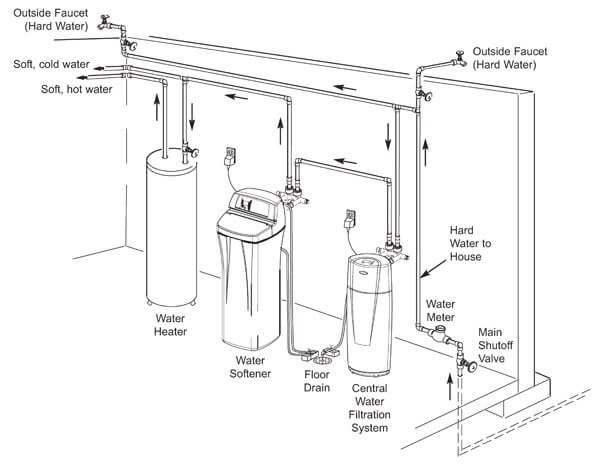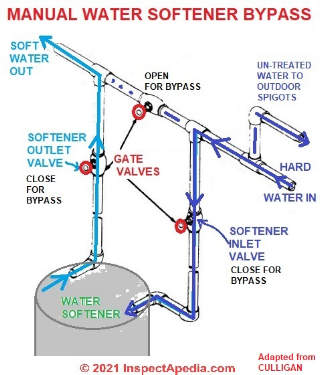Installation depends on if you're pre-plumbed for a water softener. If you are, the hookups should be coming out of the wall and connected in a loop. If the home is newer, the hookups may just be metal flex coming off of a bypass loop and installation is as easy as connecting them to your water softener. Otherwise, you may just see pipe and gate valves in a configuration like the bypass loop shown below. You will probably also have a capped off tie in to your house's drain system.
If you're not pre-plumbed, things get more complicated and you will need to know where your water main comes in and where/if a line for your outside hose bibs (faucets) comes off of it. You will have to tap into the main in your house
after that tap for the hose bibs and before your water heater. That will soften the water in your house, but not the stuff you water your lawn with. It will look something like this (no bypass loop shown):

Bypass loop:

The bypass loop allows you to cut water to each line going into and out of your softener while opening and shutting a valve that bypasses your softener. When your softener is hooked up, the bypass valve is closed and the lines are open, which only allows water into and out of your softener. If your softener needs to be serviced or replaced, the valves on the lines to and from your softener can be closed to disconnect it, and the bypass valve can be opened to keep water (unsoftened) flowing into your house. If you are not pre-plumbed, you will need to plumb this loop yourself.
Plumbing the bypass loop isn't exactly hard. The hard part is
finding where to plumb it. Your water heater is the best place to start, because the water softener should be installed immediately before where your water tees and splits into hot and cold water service. So, backtracking from your water heater's intake, find that tee and you'll find where you need to plumb. Hopefully, and probably, it is very close to your water heater. This is because the farther back it is, the more material is required by the builder since your hot and cold water will probably run the same route through your house. The hard part is that it is probably in a wall, and you will have to do some demo to find it. You will also need to put the drywall back.
You will also need to tie into your drain system so the water softener can drain when it regenerates. It will probably do this once or twice per week. Plumbing into your drain system may also be much harder, because there's no telling where you can tie in. If your water heater is near your washer and dryer, you can probably tie in to the drain that your washer uses pretty easily. If not, you will need to find a drain line somewhere near your softener and tie in. You DO NOT want to just drain to an outside wall and let the water go to your lawn. The discharge from your softener is the brine solution used to clean and regenerate the resin beads that strip out the hard minerals in your tank. It will contain a lot of salt and minerals and sterilize your lawn.
If you're not pre-plumbed, happy hunting. If you are, just find a water softener that you like at a price you're comfortable with.




